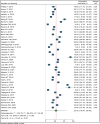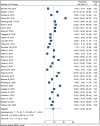A systematic review and meta-analysis of adolescent nutrition in Ethiopia: Transforming adolescent lives through nutrition (TALENT) initiative
- PMID: 37022989
- PMCID: PMC10079135
- DOI: 10.1371/journal.pone.0280784
A systematic review and meta-analysis of adolescent nutrition in Ethiopia: Transforming adolescent lives through nutrition (TALENT) initiative
Abstract
Background: Ethiopia has undergone rapid economic growth over the last two decades that could influence the diets and nutrition of young people. This work systematically reviewed primary studies on adolescent nutrition from Ethiopia, to inform future interventions to guide policies and programs for this age group.
Method: A systematic search of electronic databases for published studies on the prevalence of and interventions for adolescent malnutrition in Ethiopia in the English language since the year 2000 was performed using a three-step search strategy. The results were checked for quality using the Joanna Bridge Institute (JBI) checklist, and synthesized and presented as a narrative description.
Results: Seventy six articles and two national surveys were reviewed. These documented nutritional status in terms of anthropometry, micronutrient status, dietary diversity, food-insecurity, and eating habits. In the meta-analysis the pooled prevalence of stunting, thinness and overweight/obesity was 22.4% (95% CI: 18.9, 25.9), 17.7% (95% CI: 14.6, 20.8) and 10.6% (7.9, 13.3), respectively. The prevalence of undernutrition ranged from 4% to 54% for stunting and from 5% to 29% for thinness. Overweight/obesity ranged from 1% to 17%. Prevalence of stunting and thinness were higher in boys and rural adolescents, whereas overweight/obesity was higher in girls and urban adolescents. The prevalence of anemia ranged from 9% to 33%. Approximately 40%-52% of adolescents have iodine deficiency and associated risk of goiter. Frequent micronutrient deficiencies are vitamin D (42%), zinc (38%), folate (15%), and vitamin A (6.3%).
Conclusions: The adolescent population in Ethiopia is facing multiple micronutrient deficiencies and a double-burden of malnutrition, although undernutrition is predominant. The magnitude of nutritional problems varies by gender and setting. Context-relevant interventions are required to effectively improve the nutrition and health of adolescents in Ethiopia.
Copyright: © 2023 Abera et al. This is an open access article distributed under the terms of the Creative Commons Attribution License, which permits unrestricted use, distribution, and reproduction in any medium, provided the original author and source are credited.
Conflict of interest statement
The authors have declared that no competing interests exist.
Figures











References
-
- Das JK, Salam RA, Thornburg KL, Prentice AM, Campisi S, Lassi ZS, et al.. Nutrition in adolescents: physiology, metabolism, and nutritional needs: Adolescents: physiology, metabolism, and nutrition. Ann N Y Acad Sci. 2017. Apr;1393(1):21–33. - PubMed
-
- Biesalski Hans K, Jana T. Micronutrients in the life cycle: Requirements and sufficient supply. NFS J. 2018. Jun;11:1–11.
-
- Caskey MM, Jr VAA. Research Summary: Young Adolescents’ Developmental Characteristics.: 9.
-
- UNICEF. For every child, every right the Convention on the Rights of the Child at a crossroads [Internet]. New York: United Nations Children’s Fund; 2019. [cited 2020 Aug 15]. Available from: https://www.unicef.org/reports/convention-rights-child-crossroads-2019
Publication types
MeSH terms
Substances
Grants and funding
LinkOut - more resources
Full Text Sources
Medical

